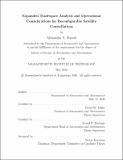| dc.contributor.advisor | David W. Miller and Daniel E. Hastings. | en_US |
| dc.contributor.author | Straub, Alexandra N.(Alexandra Nicole) | en_US |
| dc.contributor.other | Massachusetts Institute of Technology. Department of Aeronautics and Astronautics. | en_US |
| dc.date.accessioned | 2020-09-03T17:46:29Z | |
| dc.date.available | 2020-09-03T17:46:29Z | |
| dc.date.copyright | 2020 | en_US |
| dc.date.issued | 2020 | en_US |
| dc.identifier.uri | https://hdl.handle.net/1721.1/127090 | |
| dc.description | Thesis: S.M., Massachusetts Institute of Technology, Department of Aeronautics and Astronautics, May, 2020 | en_US |
| dc.description | Cataloged from the official PDF of thesis. | en_US |
| dc.description | Includes bibliographical references (pages 127-131). | en_US |
| dc.description.abstract | Earth observation (EO) satellites provide helpful imagery to a variety of applications ranging from weather monitoring to agricultural support. Disaster response imaging is an essential but difficult application for EO to support. Reconfigurable satellite constellations (ReCon) provide a flexible solution to the challenge of quickly providing imagery of unknown locations. ReCon leverages the natural shift of ground tracks due to the disparity between the Earth's rotation and the period of an orbit to maneuver a constellation into repeating ground track (RGT) orbits. This maneuvering strategy relies on altitude changes to vary an orbit's ascending node and mean anomaly, which both dictate the location of satellite's ground track. Altitude changes require significantly less fuel than plane changes. Using ReCon allows for smaller constellations to provide high-performance imagery for disaster response for a lower cost. | en_US |
| dc.description.abstract | This work explores additional trades for consideration when developing ReCon designs. The following explores satellite image scheduling techniques to further the efficacy of an Earth observation constellation. The scheduler incorporates agile satellites to add imaging targets outside of the satellite's nadir field of view. The ability for a satellite to slew to off-nadir targets is incredibly important when leveraging RGTs. Another design trade considered for ReCon is the propulsion system incorporated on the satellites. Performance and cost trades invoked when using electrical propulsion instead of chemical propulsion are presented within the ReCon framework. This work presents recommendations and future considerations to inform future designers. An investigation into the potential use of staged and responsive launch options further explores flexible options. Using alternative launch strategies allows a program to leverage dropping launch costs and adapt to uncertain imagery demand. | en_US |
| dc.description.abstract | The use of flexible options for EO satellite constellation design is vital in low Earth orbit as satellite technology improves, and space becomes a more crowded domain. | en_US |
| dc.description.statementofresponsibility | by Alexandra N. Straub. | en_US |
| dc.format.extent | 131 pages | en_US |
| dc.language.iso | eng | en_US |
| dc.publisher | Massachusetts Institute of Technology | en_US |
| dc.rights | MIT theses may be protected by copyright. Please reuse MIT thesis content according to the MIT Libraries Permissions Policy, which is available through the URL provided. | en_US |
| dc.rights.uri | http://dspace.mit.edu/handle/1721.1/7582 | en_US |
| dc.subject | Aeronautics and Astronautics. | en_US |
| dc.title | Expanded tradespace analysis and operational considerations for reconfigurable satellite constellations | en_US |
| dc.type | Thesis | en_US |
| dc.description.degree | S.M. | en_US |
| dc.contributor.department | Massachusetts Institute of Technology. Department of Aeronautics and Astronautics | en_US |
| dc.identifier.oclc | 1191824318 | en_US |
| dc.description.collection | S.M. Massachusetts Institute of Technology, Department of Aeronautics and Astronautics | en_US |
| dspace.imported | 2020-09-03T17:46:27Z | en_US |
| mit.thesis.degree | Master | en_US |
| mit.thesis.department | Aero | en_US |
